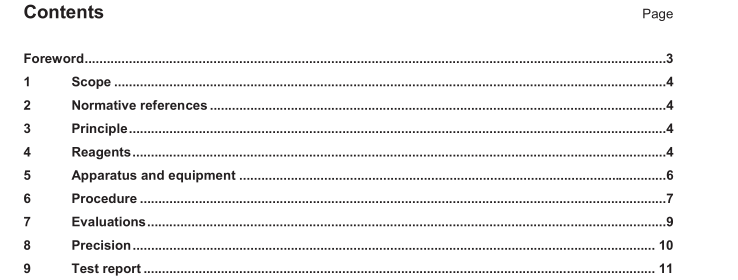EN 15764:2009 – Foodstuffs – Determination of trace elements – Determination of tin by flame and graphite furnace atomic absorption spectrometry (FAAS and GFAAS) after pressure digestion

1 Scope
This European Standard specifies a method for the determination of tin in foodstuffs and canned foods by flame and graphite furnace atomic absorption spectrometry (AAS) after pressurized digestion.
The collaborative study included foodstuffs such as carrot puree, tomato puree, pineapple, mixed fruit, white wine, peach powder, tomato powder, powdered beans, powdered fruit yoghurt, fish powder, having mass fractions of tin ranging from 43 mg/kg to 260 mg/kg (Flame-AAS) and from 2,5 mg/kg to 269 mg/kg (Graphite Furnace AAS).
2 Normative references
The following referenced documents are indispensable for the application of this document. For dated references, only the edition cited applies. For undated references, the latest edition of the referenced document (including any amendments) applies.
EN 13805, Foodstuffs — Determination of trace elements — Pressure digestion
3 Principle
The sample is mineralized through pressurized digestion with nitric acid and hydrochloric acid in accordance with EN 13805. In the resulting digestion solution, tin is quantified by flame AAS (F-AAS) or graphite furnace AAS (GF-AAS) depending on the concentration in the sample solution.
4 Reagents
4.1 General
The concentration of tin in the reagents and water used shall be low enough not to affect the results of the determination.
4.2 Nitric acid
Mass fraction w(HNO 3 ) ≥ 65 %, mass concentration ρ (HNO 3 ) ≈ 1,4 g/ml.
4.3 Hydrochloric acid
w(HCL) ≥ 30 %, ρ (HCl) ≈ 1,15 g/ml.
4.4 Tin stock solution
ρ (Sn) = 1 000 mg/l.
4.5 Tin standard and calibration solutions
4.5.1 General
The standard and calibration solutions are prepared from the stock solution by dilution in glass volumetric flasks. For calibration, prepare at least four calibration solutions of different concentrations. The acid concentration shall correspond to the concentration in the measurement solution.
4.5.2 Calibration solutions of ρ (Sn) = 5 mg/l, 10 mg/l, 20 mg/l and 30 mg/l for flame AAS. Fill four 50 ml volumetric flasks with 10 ml to 20 ml of water, add 5 ml of nitric acid (4.2) and 1 ml of hydrochloric acid (4.3) and mix. Cool the solutions to ambient temperature, and pipette exactly 0,25 ml, 0,50 ml, 1,00 ml and 1,50 ml of tin stock solution (4.4) for the respective calibration solutions of mass concentrations 5 mg/l, 10 mg/l, 20 mg/l and 30 mg/l into the four different 50 ml volumetric flasks. Mix the solutions and dilute to volume with water. These solutions are stable for at least one day. The calibration solutions described here shall be understood as examples. The concentrations prepared shall be in the linear range of the measuring device. The acid concentration of the calibration solutions shall be matched to the acid concentration in the sample solution.
4.5.3 Calibration solutions of ρ (Sn) = 0,010 mg/l, 0,020 mg/l, 0,040 mg/l and 0,060 mg/l for GF-AAS. To prepare standard solution 1 ( ρ (Sn) = 50 mg/l), fill a 50 ml volumetric flask with 10 ml to 20 ml of water, add 2,5 ml of hydrochloric acid (4.3) and mix. Cool the solution to ambient temperature, add exactly 2,5 ml of tin stock solution (4.4) and dilute to volume. This solution is stable for at least one week.
EN 15764:2009 – Foodstuffs – Determination of trace elements – Determination of tin by flame and graphite furnace atomic absorption spectrometry (FAAS and GFAAS) after pressure digestion